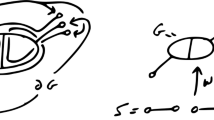Abstract
We prove, in ZFC, that there is an infinite strictly descending chain of classes of theories in Keisler’s order. Thus Keisler’s order is infinite and not a well order. Moreover, this chain occurs within the simple unstable theories, considered model-theoretically tame. Keisler’s order is a central notion of the model theory of the 60s and 70s which compares first-order theories, and implicitly ultrafilters, according to saturation of ultrapowers. Prior to this paper, it was long thought to have finitely many classes, linearly ordered. The model-theoretic complexity we find is witnessed by a very natural class of theories, the n-free k-hypergraphs studied by Hrushovski. This complexity reflects the difficulty of amalgamation and appears orthogonal to forking.
Similar content being viewed by others
References
G. Cherlin and E. Hrushovski, Finite Structures with Few Types, Annals of Mathematics Studies, Vol. 152, Princeton University Press, Princeton, NJ, 2003.
H.-D. Donder, Regularity of ultrafilters and the core model, Israel Journal of Mathematics 63 (1988), 289–322.
R. Engelking and M. Karłowicz, Some theorems of set theory and their topological consequences, Fundamenta Mathematicae 57 (1965), 275–285.
P. Erdős, A. Hajnal, A.Máté and R. Rado, Combinatorial set Theory: Partition Relations for Cardinals, Studies in Logic and the Foundations of Mathematics, Vol. 106, North-Holland Publishing Co., Amsterdam, 1984.
G. Fichtenholz and L. Kantorovitch, Sur les opérations linéaires dans l’espace des fonctions bornées, Studia Mathematica 5 (1934), 69–98.
F. Hausdorff, Über zwei sätze von G. Fichtenholz und L. Kantorovitch, Studia Mathematica 6 (1936), 18–19.
E. Hrushovski, Pseudo-finite fields and related structures, in Model Theory and Applications, Quaderni di Matematica, Vol. 11, Aracne, Rome, 2002, pp. 151–212.
E. Hrushovski, Stable group theory and approximate subgroups, Journal of the American Mathematical Society 25 (2012), 189–243.
H. J. Keisler, Good ideals in fields of sets, Annals of Mathematics 79 (1964), 338–359.
H. J. Keisler, Ultraproducts which are not saturated, Journal of Symbolic Logic 32 (1967), 23–46.
S. Kochen, Ultraproducts in the theory of models, Annals of Mathematics 74 (1961), 221–261.
P. Komjáth and S. Shelah, Two consistency results on set mappings, Journal of Symbolic Logic 65 (2000), 333–338.
K. Kunen, Ultrafilters and independent sets, Transactions of the American Mathematical Society 172 (1972), 299–306.
A. Macintyre, A history of interactions between logic and number theory, 2003 Arizona Winter School manuscript (2003), swc.math.arizona.edu/aws/2003/03MacintyreNotes.pdf.
M. Malliaris and S. Shelah, A dividing line within simple unstable theories, Advances in Mathematics 249 (2013), 250–288.
M. Malliaris and S. Shelah, General topology meets model theory, on p and t, Proceedings of the National Academy of Sciences of the United States of America 110 (2013), 13300–13305.
M. Malliaris and S. Shelah, Constructing regular ultrafilters from a model-theoretic point of view, Transactions of the American Mathematical Society 367 (2015), 8139–8173.
M. Malliaris and S. Shelah, Saturating the random graph with an independent family of small range, in Logic Without Borders, DeGruyter, Berlin–Boston–Munich, 2015.
M. Malliaris and S. Shelah, Cofinality spectrum theorems in model theory, set theory, and general topology, Journal of the American Mathematical Society 29 (2016), 237–297.
M. Malliaris and S. Shelah, Existence of optimal ultrafilters and the fundamental complexity of simple theories, Advances in Mathematics 290 (2016), 614–681.
M. E. Malliaris, Persistence and regularity in unstable model theory, ProQuest LLC, Ann Arbor, MI, 2009, Thesis (Ph.D.)–University of California, Berkeley.
M. E. Malliaris, Realization of ϕ-types and Keisler’s order, Annals of Pure and Applied Logic 157 (2009), 220–224.
M. E. Malliaris, Independence, order, and the interaction of ultrafilters and theories, Annals of Pure and Applied Logic 163 (2012), 1580–1595.
S. Mohsenipour and S. Shelah, Set mappings on 4-tuples, paper 1072. Notre Dame Journal of Formal Logic, Accepted.
J. T. Moore, Model theory and the cardinal numbers p and t, Proceedings of the National Academy of Sciences of the United States of America 110 (2013), 13238–13239.
M. Morley, 1968 Mathscinet review MR0218224 of Keisler [10].
S. Shelah, Classification Theory and the Number of Nonisomorphic Models, Studies in Logic and the Foundations of Mathematics, Vol. 92, North-Holland Publishing Co., Amsterdam, 1990.
S. Shelah, On what I do not understand (and have something to say), model theory, Mathematica Japonica 51 (2000), 329–377.
W. Sierpiński, Cardinal and Ordinal Numbers, Monografie Matematyczne, Vol. 34, Państowe Wydawnictwo Naukowe, Warsaw, 1965.
Author information
Authors and Affiliations
Corresponding author
Additional information
Malliaris was partially supported by a Sloan research fellowship, by NSF grants DMS-1300634 and DMS-1553653, and by a research membership at MSRI funded through NSF 0932078 000 (Spring 2014).
Shelah was partially supported by European Research Council grant 338821, and NSF grant 1362974 (Rutgers).
Rights and permissions
About this article
Cite this article
Malliaris, M., Shelah, S. Keisler’s order has infinitely many classes. Isr. J. Math. 224, 189–230 (2018). https://doi.org/10.1007/s11856-018-1647-7
Received:
Revised:
Published:
Issue Date:
DOI: https://doi.org/10.1007/s11856-018-1647-7



